[1]
G. Box, W. Hunter, Statistics for experimenters: an introduction to design, data analysis and model building, Wiley, New York, (1978).
Google Scholar
[2]
M. Lombardo, Ş. Ţălu, M. Ţălu, S. Serrao, P. Ducoli, Surface roughness of intraocular lenses with different dioptric powers assessed by atomic force microscopy, Journal of Cataract & Refractive Surgery, 36, 9 (2010) 1573 -1578.
DOI: 10.1016/j.jcrs.2010.06.031
Google Scholar
[3]
Ş. Ţălu, Characterization of surface roughness of unworn hydrogel contact lenses at a nanometric scale using methods of modern metrology, Polymer Engineering and Science, 53, 10 (2013) 2141-2150.
DOI: 10.1002/pen.23481
Google Scholar
[4]
A.C. Cîrstoiu, Research on quality of processed surface by turning on conventional and CNC machine tools, Metalurgia Internaţional, 10 (2010) 5 – 11.
Google Scholar
[5]
N. Suleyman, Y. Suleyman, T. Erol, Optimisation of tool geometry parameters for turning operations based on the response surface methodology, Measurement 44 (2011) 580-587.
DOI: 10.1016/j.measurement.2010.11.018
Google Scholar
[6]
C. Tache, I. Petre, D. Dumitru, Studies about determination of the tool temperature during the cutting process, Proceedings of the 4th International conference on advanced manufacturing technologies, Editura Academiei Romane, Bucuresti, 2005, 525 – 526.
Google Scholar
[7]
Şt. Enache, La qualité des surfaces métaliques, Ed. Tehnică, Bucureşti, (1994).
Google Scholar
[8]
M. Petraru, O. Pruteanu, N. Ionescu, A. Visan, A. Cîrstoiu, Experimental modelling of the turning process of some steels used for railway trucks axle machining, Proceedings of the 15th International Conference Modern Technologies, Quality and Innovation - Iaşi & Chişinău - ModTech2011-New face of T.M.C.R., Editura Politehnium, Iaşi, 2011, 853- 856.
Google Scholar
[9]
C. Marin, F. Popa, Al. Marin, Dynamic stresses occurring at haversin impulse shock loading of an elastic system, The Scientific Bulletin of Valahia University Materials and Mechanics, 4(2009) 217-220.
Google Scholar
[10]
E. Diacenko, M. O. Iacobson, Calitatea suprafeţelor la prelucrarea metalelor prin aşchiere (translation from Russian), Ed. Tehnică, Bucureşti, (1954).
Google Scholar
[11]
G. Boothroyd, Fundamentals of Metal Machining and Machine Tools, Dekker, New York, (1989).
Google Scholar


